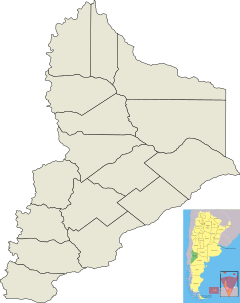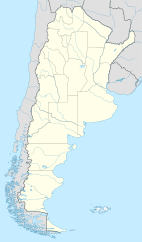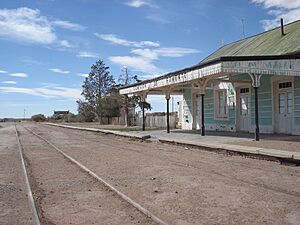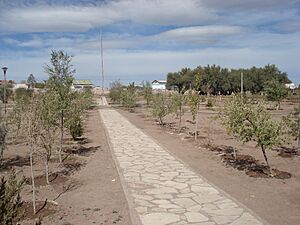Ramón M. Castro facts for kids
Quick facts for kids
Ramón M. Castro
|
|
|---|---|
|
Municipality and village
|
|
| Country | |
| Province | Neuquén Province |
| Population
(2010)
|
|
| • Total | 317 |
| Time zone | UTC-−3 (ART) |
Ramón M. Castro is a small village and municipality located in the Zapala Department, Neuquén Province in southwestern Argentina. In 2010, about 317 people lived there.
Contents
A Look into Ramón M. Castro's Past
The area where Ramón M. Castro is located has a long and interesting history.
Who Lived Here First?
The first people to live in this land were Mapuche groups, who are indigenous people. Later, nomadic farmers also settled here. They moved around, trading cattle, salt, and other goods. Pioneer settlers and families from Europe, especially from the Basque region, also came to live and work in the area.
Why People Moved to This Area
There was a lot of open land in Ramón M. Castro, and it was close to Chile. This made many people want to move there. These new residents settled on the large government-owned lands. They started a life focused on farming and raising animals, often moving their herds. This way of life became very common in the mid-1800s.
The population grew even more when the Province of Neuquén became part of Argentina's plan to export farm products. The arrival of the General Roca Railway also brought many changes.
The Railway Arrives
In the late 1800s, the government started to organize the land better. This included military actions and setting up army bases near the border with Chile.
Around this time, an engineer named Ramón Castro gave land for a new railway station. This station opened on October 21, 1937, and was named Ramón M. Castro. The General Roca Railway company built these new railway lines, connecting the area to other places.
How the Railway Changed the Town
Having a railway station helped the town use its natural resources more. The soil in the area had a lot of clay. With the railway to transport goods, people started making bricks and hollow ceramic products. This created many jobs and allowed them to sell their products far away.
There were two large brick ovens in the center of town. The best clay was found in an area called Anticlinal, which is part of Ramón M. Castro. People from Anticlinal would dig up the clay and bring it to the town. Many residents worked in making bricks and ceramics.
Life and Work in the Past
A large number of people in Ramón M. Castro worked for the railway company. They had jobs as technicians, train drivers, and warehouse workers. The first groups of settlers were good at moving their animals. They would take their livestock from the dry "winter" fields to the higher mountain valleys, called "veranadas," during the summer.
Population Changes Over Time
At its busiest, Ramón M. Castro had about 1,000 residents. However, by 2010, the population had dropped to around 555 people. This number includes those living in the main town and its six surrounding areas.
Communities and Culture
Ramón M. Castro includes several small places called parajes, which are like small roadside communities. These include Santo Domingo, Barda Negra, and Anticlinal. There are clear differences between the communities of Mapuche descendants and other residents.
- In Santo Domingo, you can find the Ñaly Ko indigenous community, made up of 35 families.
- In Barda Negra, there is the Calfucurá community, with about 18 families.
- In other areas, the Antipán community lives, with 16 families.
There are also provincial festivals in Zapala where people from different places come together. The evangelical church organizes many festivals too. Evangelism has become an important part of life for many people in the area. Some say that because of the church, alcoholic drinks are no longer common at festivals.
See also
 In Spanish: Ramón M. Castro para niños
In Spanish: Ramón M. Castro para niños





